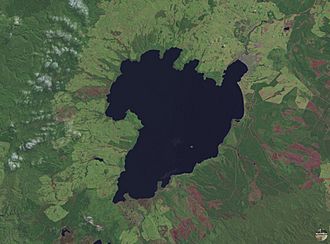Hatepe eruption facts for kids
Quick facts for kids Hatepe eruption |
|
|---|---|

|
|
| Volcano | Lake Taupo |
| Date | About 180 CE |
| Type | Phreatomagmatic, Ultra-Plinian |
| Location | Lake Taupo, North Island, New Zealand 38°49′S 175°55′E / 38.817°S 175.917°E |
| VEI | 7 |
| Impact | Devastated local vegetation, expanded Lake Taupo, flooded the Waikato River |
The Hatepe eruption was a huge volcanic explosion that happened around 180 CE. It's also sometimes called the Taupo eruption. This powerful event came from the Taupo Volcano in New Zealand. It was the biggest eruption in New Zealand in the last 20,000 years!
The eruption blasted out about 120 cubic kilometers of material. Imagine a cube with sides 4.9 kilometers long – that's how much rock and ash was thrown into the air! About 30 cubic kilometers of this came out in just a few minutes. This makes it one of the largest eruptions in the last 5,000 years. It was similar in size to other famous eruptions like the Minoan eruption and the 1815 eruption of Mount Tambora.
Contents
Stages of the Hatepe Eruption
The Hatepe eruption happened in several steps. Scientists have found six clear layers of ash and rock that show these different stages. Even though the melted rock (called magma) was all the same type, the eruption acted in many ways. It included weak explosions caused by water mixing with magma (called phreatomagmatism), very powerful explosions (called Plinian eruptions), and huge fast-moving clouds of hot gas and ash (called pyroclastic flows).
Years or decades after the main eruption, new lava domes formed. These created the Horomatangi reefs and Waitahanui bank in Lake Taupo.
Impact of the Pyroclastic Flow
The main pyroclastic flow from the Hatepe eruption was incredibly destructive. It covered the land within 80 kilometers of the volcano with a type of rock called ignimbrite. This hot, fast-moving cloud even climbed over mountains like the Kaimanawa Range and Mount Tongariro, which are more than 1,500 meters high.
At the time of the eruption, no humans lived in New Zealand. The Māori didn't settle there until over 1,000 years later. This means no people were directly harmed by this massive event.
Lake Taupo's Transformation
The Hatepe eruption also changed Lake Taupo a lot. The lake had formed after an even bigger eruption called the Oruanui eruption, about 26,500 years ago. The Hatepe eruption blocked the lake's old outlet. This caused the lake's water level to rise by 35 meters, much higher than it is today. Eventually, the lake broke through, causing a huge flood. This flood flowed for more than a week, at about 200 times the speed of the Waikato River today!
Scientists have also found signs of tsunamis from the same time along the coast of central New Zealand. This shows that the eruption caused big waves in the lake and possibly even wider ocean waves, similar to those seen after the 1883 Krakatoa eruption.
Dating the Eruption
For many years, people thought the Hatepe eruption happened exactly in 186 CE. This idea came from research by Colin J. N. Wilson and others. It seemed to match descriptions of strange weather events in ancient China and the Roman Empire. However, scientists now question this exact date.
Earlier estimates for the Taupo eruption ranged from 131 CE to 233 CE. Some dates were based on carbon-14 from burnt plants found in the eruption's layers. But the samples used had a wide range of dates, making the average date less certain.
Most geologists now agree that the amount of ash and pumice (a light, airy rock) from the eruption was much larger than first thought. It was about 150 cubic kilometers, not just 14 cubic kilometers. A later study in 1995 used radiocarbon dating and suggested the eruption happened around 233 CE, give or take 13 years. Some scientists also think that certain elements in the groundwater might have made the older dates seem even older than they were. This means the Hatepe eruption might have happened decades or even centuries later than first believed.
At the time of the eruption, the closest people lived in Tonga, which is over 1,700 kilometers away to the northeast.
See also
 In Spanish: Erupción de Hatepe para niños
In Spanish: Erupción de Hatepe para niños

